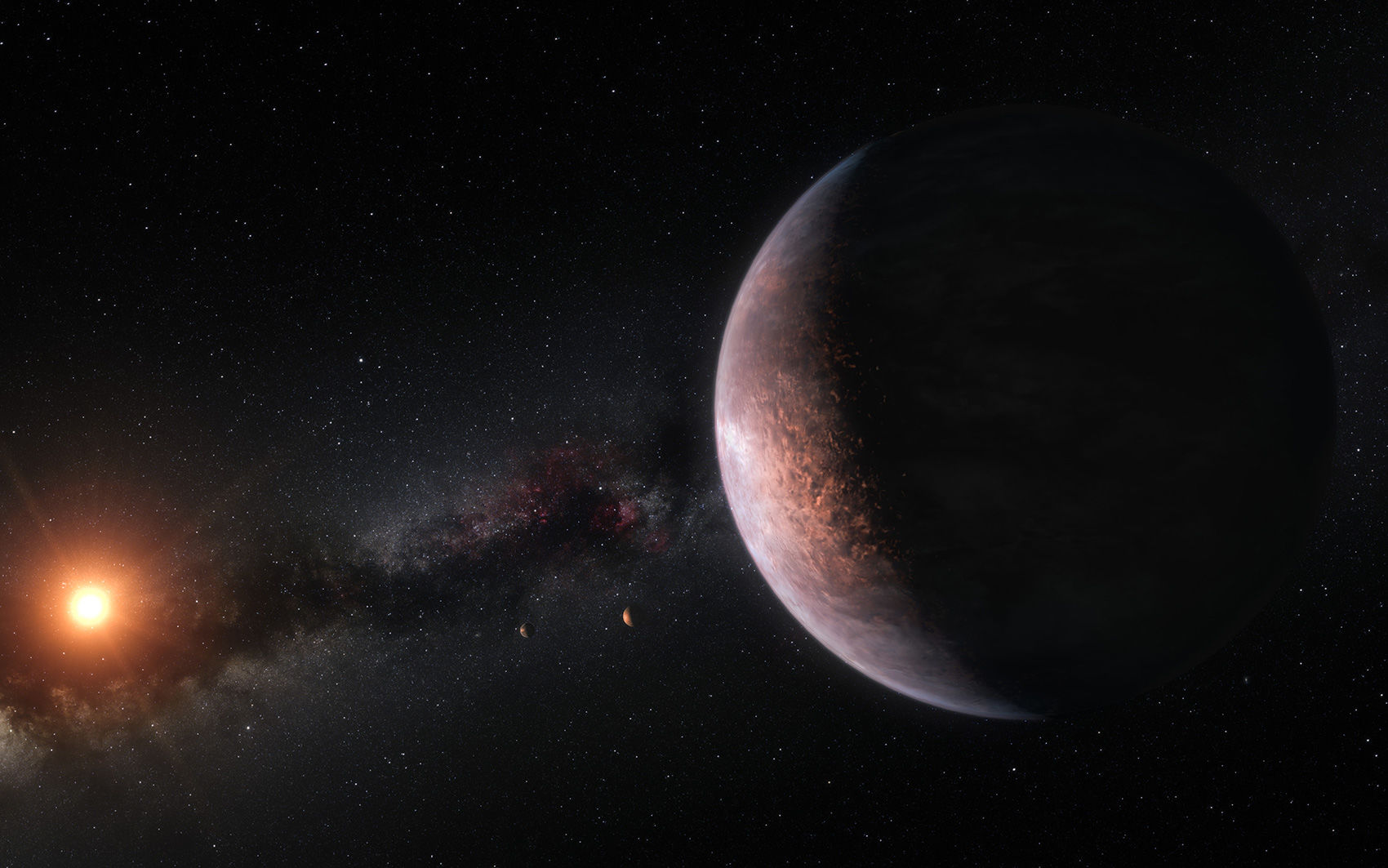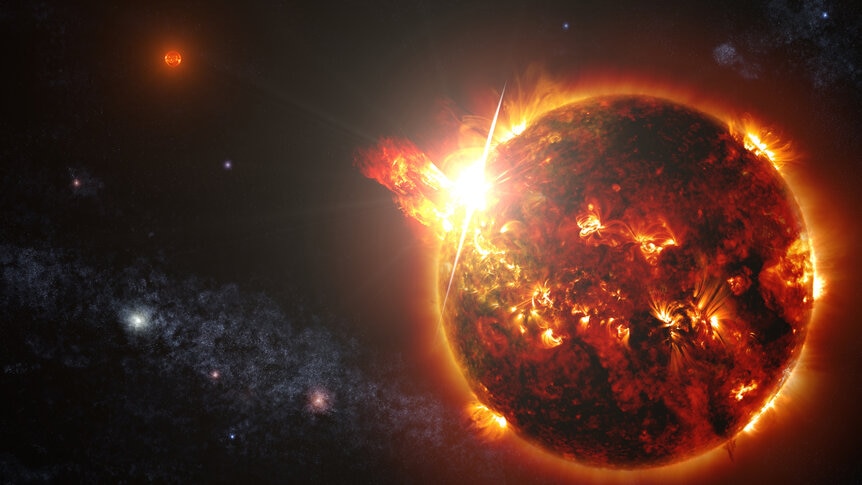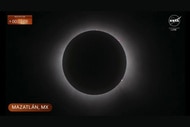Create a free profile to get unlimited access to exclusive videos, sweepstakes, and more!
The Red Sky Paradox: Why do we orbit a star like the Sun instead of a red dwarf?

Here’s what seems like a weird question: Why do we orbit a star like the Sun instead of a red dwarf?
Think of it in a probability sense: Red dwarfs (called M dwarfs by astronomers) are far more common than stars like the Sun (G dwarfs; slightly hotter ones are called F and cooler ones K), and also “live” much longer (they can remain stably fusing hydrogen into helium in their cores for hundreds of billions of years, and some longer), so it’s a reasonable assumption that by far most habitable planets would be around M dwarfs.
In that sense, it’s really odd we orbit a star like the Sun. Statistically speaking — by a factor of about 100 to 1 — we should be orbiting a red dwarf. Why don’t we?
One way to resolve this is to just assume we’re outliers; most habitable (and possibly inhabited) planets do orbit red dwarfs, and we just happen to be one of the very few that don’t. That’s a little unsatisfying, though: It’s too easy an answer. We don’t really know how often intelligent life occurs on other planets (or even if it does at all), so just saying “We’re lucky” isn’t something you can back up with any evidence.
In fact, you can ask the more general question, “Is there intelligent life out there?” and think that there must be, because life took hold on Earth quickly (and we emerged after a few billion years), and we know there are lots of planets out there. But that’s statistically difficult to back up, and in fact you need to employ what’s called Bayesian statistics to answer the question well. This form of statistics is a little different than what you’re used to. I described it in an earlier post:
It's different than normal statistics, in that it allows for prior knowledge to be used in the calculation, and allows you to learn from it the next time you run the math. So, say, if you ask the odds of a coin flip being heads, you'd say 50/50. But if you know the coin is slightly off-balance, and that tips the odds, you can use Bayesian methods to find out what your best bet would be. Flip the coin again, and you can use the results to feed back into your system.
In fact, that article talks about using Bayesian statistics to try to understand the odds of intelligent life in the Universe, using the work of astronomer David Kipping. It’s not a coincidence that I quote his research: Using the same sort of methods, he’s tackled what he called the Red Sky Paradox in a new paper, trying to understand why we don’t orbit a red dwarf.
Looking at the statistics, and using our understanding of things like how often certain kinds of stars are born, how long they live, how often they have habitable planets, and how long life and intelligence take to emerge, Kipping determines what it would take to raise the odds of orbiting a Sun-like star versus a red dwarf from 1 in 100 to something more likely — in other words, finding ways it’s harder for intelligence to be on planets orbiting red stars versus ones like the Sun. These input conditions affect the output statistics, so resolving the paradox means looking at those more carefully.
He finds that any one of four conditions has to be true to make it more likely we orbit a Sun-like star.
The first is that, as our intuition might sway us, we really are unusual. If habitable planets occur with even odds around M dwarfs versus a Sun-like star, and intelligence emerges on them, then we’d have to be unusual!
But we can also look at the rate of the emergence of intelligence, as he did in his first paper. Using Bayesian math, he finds that if it evolves rapidly then there is a 1 in 6 chance it will happen around a Sun-like star versus a red dwarf. If it emerges slower, the chances drop to more like 1 in 100.
That 1 in 6 is palatable, and makes sense because if intelligence gets started quickly the long lives of M dwarfs don’t matter; any star that makes habitable planets doesn’t need hundreds of billions of years to do so. An argument against this, though, is that it did take a long time for us to arise, so it’s more likely that the odds are 1 in 100 we don’t orbit a red dwarf, which again is a problem.
Kipping notes that this comes into tension with the Copernican Principle: The assumption that we don’t live in a special place or time in the Universe. However this is more of a guideline than a rule, and I would argue we do live in a special time: The Universe needs time to make heavy elements for us to exist, for example, so life like us existing before the Universe was a few billion years old is unlikely. So I am not hugely opposed to this.
He also notes that if intelligence arises quickly then we also run into the Fermi Paradox: Aliens should be everywhere, but if so why haven’t they visited us? I chuckled when I read that; I just wrote about a solution to this last week! Maybe it is out there and common, but separated from us by enough space that visiting us is difficult. Or, they did visit us, but it was millions of years ago. Time is long.
A second solution is that M stars don’t develop habitable planets and intelligent life at the same rate as Sun-like stars. There could be many reasons for that: They don’t make planets as often, or the planets don’t become habitable because they’re so close to their star they get tidally locked, and life becomes more difficult to arise. He finds that for whatever reason, if they make life at a rate 1/100th as much as around Sun-like stars this resolves the paradox. This may be able to be confirmed using observations, but we don’t have enough data yet.
A third solution would be that the window for life to arise around a red dwarf is truncated somehow. For example, red dwarfs are known to be extremely active magnetically and blast off huge flares that can torch any close-in planets. It takes roughly a billon years for them to settle down, and in that time the planet can suffer a runaway greenhouse effect it cannot recover from. Planets farther out might be spared and even warmed by this, but that’s temporary. If the window for life to emerge is 1/5th as long as for a Sun-like star, the paradox is lifted; the odds of life arising around either kind of star would be roughly even. In fact, we do see something like this, so this is a viable solution.
The fourth solution is that there just may be fewer habitable planets around M stars. Observationally we find that 16% might have Earth-like planets (ones the same size as Earth and far enough from the star to potentially have liquid water on their surfaces). That number increases to ~35% for Sun-like stars.
But we don’t know if those red dwarf planets would really be habitable. Many may have started as more Neptune-like and had their atmospheres blasted off by the star — this sort of thing has been seen. Those wouldn’t make for good homeworlds. There are many other ways to make planets uninhabitable, too.
If intelligent life is rare (arising slowly), then habitable planets would have to be 1/100th as common around red dwarfs as Sun-like stars to resolve the paradox. If it’s common (arising quickly) then that fraction becomes more like 1/5th, which isn’t too tough. But then we run into the same problems we had with the first resolution involving rapid rise of intelligence.
In the end, Kipping finds the first solution to be unlikely, but any one of the other three possible under limited circumstances. The fourth one can be determined using observations, trying to establish how common habitable planets really are around red dwarfs. The third might be possible to observe by using future infrared telescopes to see if planets around red dwarfs have suffered runaway greenhouse effects, too.
The bottom line: We don’t have enough data to know which of these solutions (or something we haven’t thought of yet) is correct. But assuming Kipping’s approach is correct, we have the framework to understand this problem. Once we do have those observations, we can finally determine if our Sun-like star was a physical inevitability, or if we’re just really, really lucky.















